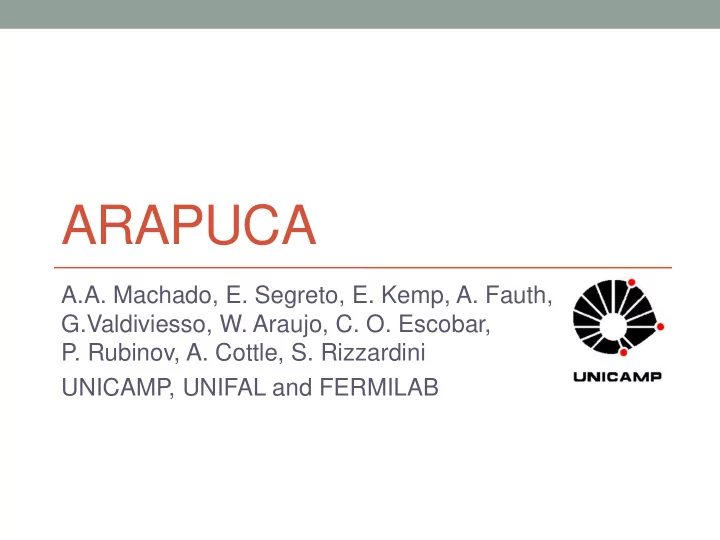

ARAPUCA A.A. Machado, E. Segreto, E. Kemp, A. Fauth, G.Valdiviesso, W. Araujo, C. O. Escobar, P. Rubinov, A. Cottle, S. Rizzardini UNICAMP, UNIFAL and FERMILAB
2 PD meeting 18th May 2016 ARAPUCA an alternative photon detection technique for Large Liquid Argon TPC • ARAPUCA a brief review • Testing the trap effect – @ UNICAMP • Testing in the liquid argon – @ FERMILAB • Perspectives
3 PD meeting 18th May 2016 Idea • ARAPUCA ( A rgon R &D A dvanced P rogram @ U ni CA mp) in the language of native Brazilian means trap for birds • The idea at the basis of the ARAPUCA is to trap photons inside a box with highly reflective internal surfaces, so that the detection efficiency of trapped photons is high even with a limited active coverage of its internal surface
4 PD meeting 18th May 2016 The dichroic filter • The core of the device is a dichroic filter . It is a multilayer acrylic film - same technology used to produce reflective plastic foils like 3M VIKUITI or VM2000. • It has the property of being highly transparent for wavelength below a cutoff and highly reflective above it. Transmittance Reflectance cutoff cutoff
5 PD meeting 18th May 2016 Operating principle I • The simplest geometry is a flattened box with highly reflective internal surfaces (Teflon) with an open side. Dichroic filter SIPM • The open side hosts the dichroic filter that is the acceptance window of the device • The filter is deposited with TWO SHIFTERS – one on each side • The shifter on the external side , S1, converts LAr scintillation light to a wavelength L1, with L1 < cutoff • The shifter on the internal side , S2, converts S1 shifted photons to a wavelength L2, with L2 > cutoff • The internal surface of the ARAPUCA is observed by one or more SiPM
6 PD meeting 18th May 2016 The Operating Principle II • After the first shift the light enters the ARAPUCA since the filter is transparent • After the second shift the photon gets trapped inside the box because the filter turns to be reflective • Photons are detected by the SiPM after some reflections
7 PD meeting 18th May 2016 Verifying the trapping process Experimental tests performed at room temperature in a black box @ UNICAMP • Was used a small prototype with a window of 3.5 cm x 2.3 cm We used as shifters P-Terphenyl ( l ~ 350 nm ) for the external side • and TPB ( l ~ 430 nm ) for the internal one. • The cutoff of dichroic = 400 nm • Using an alpha source to excite scintillation of the external shifter • Coupled the ARAPUCA to a PMT slit
8 PD meeting 18th May 2016 ARAPUCA with two different windows 1. Glass coated with TPB => NO TRAPPING EFFECT 2. Filter coated with pTP and TPB => TRAPPING EFFECT Glass/Filter PMT ARAPUCA
9 PD meeting 18th May 2016 Normalize the input light We measured the total amount of light produced by the alpha source gluing the glass or filter directly on the PMT. The comparison of the measured spectra allows to determine the collection efficiency. Glass/Filter PMT
10 PD meeting 18th May 2016 No trapping effect - TPB on glass 10 3 entries entries 10 3 10 2 10 2 10 10 1 1 0 100 200 300 400 500 600 0 100 200 300 400 500 600 photo-electrons photo-electrons Collection efficiency ~ 20%
11 PD meeting 18th May 2016 Trapping effect - ARAPUCA (filter) Collection efficiency ~ 50%
12 PD meeting 18th May 2016 Test in LAr @ FERMILAB (I) • Arapuca with 5x5 cm 2 acceptance window; • Box with dimensions 5x5x0.6 cm 2 • Read-out by 2 SiPM 0.6cm X 0.6cm active area each SensL MicroFC-60035-SMT (courtesy of Cormac Campbell - SensL Technologies Ltd.)
13 PD meeting 18th May 2016 Test in LAr @ FERMILAB (II) • The device has been installed inside a liquid argon cryostat (SCENE) and exposed to an alpha source. • Alpha source is 241 Am that produces 5.4 MeV monochromatic particles • Two different runs have been performed and two different read-out electronics have been tested a source
14 PD meeting 18th May 2016 Test in LAr @ FERMILAB (III) Waveform detected for the two channels with positive bias
15 PD meeting 18th May 2016 Test in LAr @ FERMILAB (IV) Waveform detected for the two channels with negative bias
16 PD meeting 18th May 2016 Test in LAr @ FERMILAB (V) Average waveform SiPM 1
17 PD meeting 18th May 2016 Final considerations • The principle of the ARAPUCA works • Even with a totally non optimized prototype the trapping effect is clearly visible • A 5x5cm 2 prototype has been tested in LAr at Fermilab, Many Thanks to H.Lippincot , S.Pordes , SensL and all the PAB team
Backup Slides
19 PD meeting 18th May 2016 More wave forms
24 PD meeting 18th May 2016 HOW MANY PHOTONS DO WE EXPECT IN THE ARAPUCA? Geometrical acceptance: 0.064 Early+ late light yield: 40,000 VUV photons/MeV Alpha energy: ~ 5 MeV At the window of the trap: 12,000 128nm fotons Arapuca efficiency: a few % 120 fotons/alpha enter the Arapuca for every % efficiency of the trap.
Recommend
More recommend